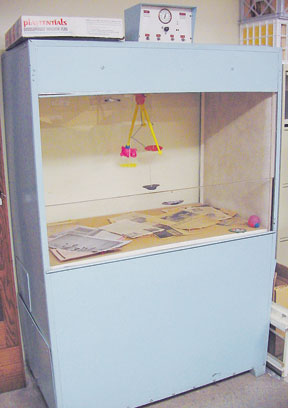Baby in a Crib Moving Mobile Psychology Experiment
Observation
Skinner Air Crib
September ane, 2010

Skinner'south Air Crib
1944, B.F. Skinner and his married woman, Yvonne, were expecting their second child. After raising one infant, Skinner felt that he could simplify the process for parents and improve the experience for children. Through some tinkering, he created the "air crib," a climate controlled environment for an infant. I of these air cribs resides in the gallery at the Center for the History of Psychology in Akron, Ohio.
Skinner had high hopes that the air crib would ease parental burdens and contribute positively to children's development. Skinner was especially concerned about rearing a baby in the harsh environment of Minnesota where he lived and worked. Keeping the child warm was a central priority. Traditionally, this meant wrapping the baby in clothes and blankets. This not only inhibited the child's self-directed movement, but the baby could easily overheat as well. It also meant labor for parents, from more than laundry to frequent bathing of the child.
The air crib was intended to dispense with these concerns. In terms of design, the air crib was basically an oversized metal crib just with a ceiling, three solid walls and a safe-glass pane at the front which could be lowered to movement the baby in and out of the crib. Sail was stretched to create a floor. Sheeting was be rolled on tiptop of the canvas and easily rolled off when soiled. Parents regulated the temperature and humidity of the crib via a control box on peak of the crib and clean air was filtered into the crib from below. The crib was also higher than other cribs of the twenty-four hours, allowing easier access to the kid without the burden of stooping over.
Skinner's second daughter, Deborah slept and played in this new crib during the start 2 years of her life. By all accounts she had a salubrious, happy childhood and adulthood. The cribs were commercially produced and information technology is estimated that over 300 children were raised in them. Psychology Today ran a short piece on the air crib where the authors tracked down 50 children that used the air crib. The results for these children were positive and the parents enjoyed using the crib. Yvonne also believed it was superior to a standard crib (Epstein, 1995).
So why did the air crib fail to grab on? Why has it become an archival display piece rather than a standard tool for childrearing? Public perception of the air crib was anything simply positive. When Ladies Home Journal ran a slice on the new crib in 1945, the American public got its first glimpse into the curious new invention (Skinner, 1945). The title of the commodity, "Infant in a Box," as well as Skinner's utilize of the discussion "experiment" to describe the experience likely contributed to public skepticism about the device (Bjork, 1997). The paradigm accompanying the article was similarly damaging; information technology showed Deborah enclosed within the crib, peering out with her face up and hands pressed up against the glass. In addition, select parts of the article were reprinted in other major outlets. Every bit a upshot, many readers did non get the entire story. Some began to make inferences most the nature of the crib based on the much more famous Skinner box. The air crib therefore became associated with rewards, pellets, levers, and the like. People were also wary of using scientific discipline and engineering as aids or peradventure replacements for the loving labor of the female parent. Companies also rejected the idea because whatever issues with such a device could upshot in exceedingly negative publicity (Benjamin & Nielson-Gammon, 1999; Bjork, 1997).
The controversy over the air crib somewhen grew into an urban legend about Skinner'southward daughter, Deborah. This legend grew out of the causeless psychological impairment of raising a child in an air crib. It was rumored that Deborah's early on experiences in the crib acquired her to go crazy, sue her father, and commit suicide. These legends are in fact fake; Deborah grew upwardly normally, has talked very positively nearly her childhood, and has no bug with the air crib (Skinner-Buzan, 2004).
The fascinating story of the air crib highlights the tensions between science, technology, and everyday life. People were so concerned about the possible negative ramifications of this new blazon of crib that they ignored its potential benefits. Skinner and his married woman identified 19 different positive results for both them and their daughter from utilize of the air crib. A few air cribs practice all the same exist today, some homemade and some passed on from parent to child, but Skinner's vision of the air crib equally the childrearing device of the time to come never materialized. Public opinion on the device could not be swayed and the possibility of the air crib revolution was relegated to history. ♦
References
Benjamin, Fifty.T., Jr. & Nielson-Gammon, East. (1999). B.F. Skinner and psychotechnology: The instance of the heir conditioner. Review of General Psychology, three, 155-167. doi:10.1037/1089-2680.3.iii.155
Bjork, D. W. (1996). B. F. Skinner: A life. Washington, DC: American Psychological Association.
Epstein, R. (1995, November 1). Babies in boxes. Psychology Today. Retrieved from http://psychologytoday.com/articles/pto-19951101-000010.html
Skinner, B. F. (1945). Baby in a box: The mechanical baby-tender. The Ladies Home Periodical, 62, 30-31, 135-136, 138.
Skinner-Buzan, D. (2004, March 12). I was non a lab rat. Guardian. Retrieved from http://www.guardian.co.united kingdom/didactics/2004/mar/12/highereducation.uk
Source: https://www.psychologicalscience.org/observer/skinner-air-crib
0 Response to "Baby in a Crib Moving Mobile Psychology Experiment"
Post a Comment